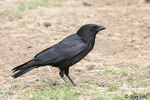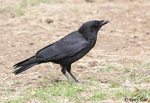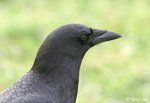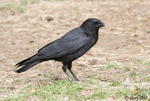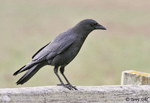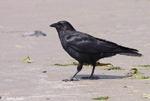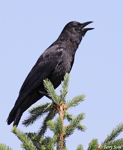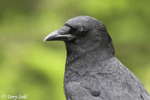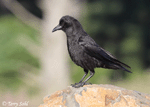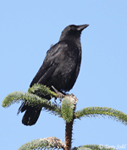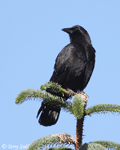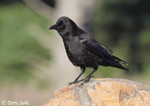| Length: 17 inches | Wingspan: 36 - 39 inches | Seasonality: All Seasons |
| ID Keys: Completely black body, bill, and legs, large strong bill, fan-shaped tail. | ||
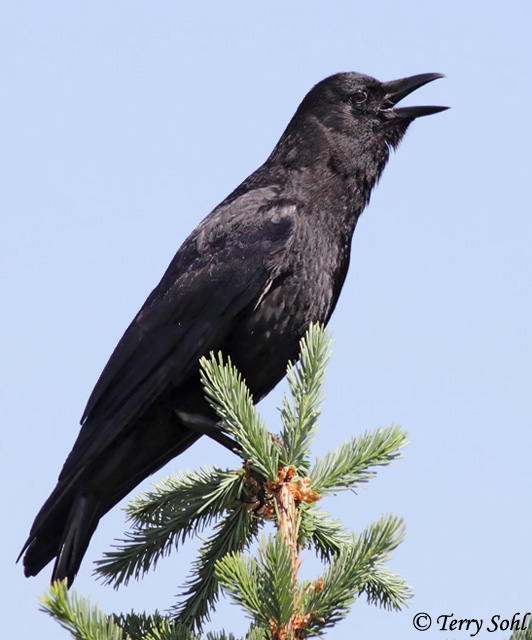 The American Crow is one
of the most widespread and adaptable birds in North America. Its call of
caw-caw
is widely familiar, as is the distinctive slow flapping flight. An
intelligent bird, the American Crow has survived widespread persecution, and has
adapted to most human-altered landscapes. They can be just as
well adapted to heavily altered landscapes (such as agricultural land or urban
settings) as they are to natural landscapes.
The American Crow is one
of the most widespread and adaptable birds in North America. Its call of
caw-caw
is widely familiar, as is the distinctive slow flapping flight. An
intelligent bird, the American Crow has survived widespread persecution, and has
adapted to most human-altered landscapes. They can be just as
well adapted to heavily altered landscapes (such as agricultural land or urban
settings) as they are to natural landscapes.
Habitat:
Wide variety of open to semi-open habitats, from rural agricultural areas to city parks.
Diet:
Omnivorous. Will eat a very wide array of items, including seeds, waste grain, berries and other fruit, insects, earthworms, snails, frogs, small snakes and lizards, small rodents, crustaceans, mollusks, eggs and young birds, garbage, and carrion.
Behavior:
Extremely intelligent and opportunistic, with individual birds or groups of birds often specializing in specific foraging techniques. Wide variety of behaviors depending upon location and situation.
Nesting:
April through June. The nest of an American Crow is a large basket of sticks, weed stems, bark strips, and mud, lined with softer material such as mosses, leaves, grasses, feathers, and animal hair. The Female lays between 3 and 8 eggs, and she does most, if not all, of the incubating. When the eggs hatch, both parents help feed the young, and they are sometimes assisted by "helper" birds in a cooperative nesting behavior. The young leave the nest after about 4 weeks.
Interactive eBird Map:
Click to access an interactive eBird map of American Crow sightings
Song:
Migration:
Generally a permanent resident throughout the majority of the United States. Those in the extreme northern U.S. and in Canada move south in the fall.
Similar Species:
In range, most likely to be confused with the Common Raven or Fish Crow or Chihuahuan Raven.
Conservation Status:
Extremely adaptable, the American Crow has withstood countless attempts at eradication. It has adapted well to living with humans and is probably more abundant today than it has ever been. They are found over a wide geographic region, and they are very common in many areas. The IUCN lists the American Crow as a species of "Least Concern".
Further Information:
Photo Information:
June 2009 - Central Oregon - Terry Sohl
Additional Photos:
Click on the image chips or text links below for additional, higher-resolution American Crow photos.
| Click on the map below for a higher-resolution view |
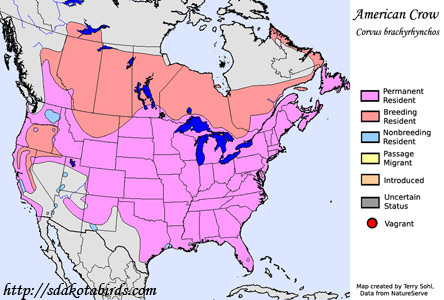 |
| South Dakota Status: Common permanent resident throughout the state |
Additional American Crow Photos
Click for a higher-resolution version of these photos
